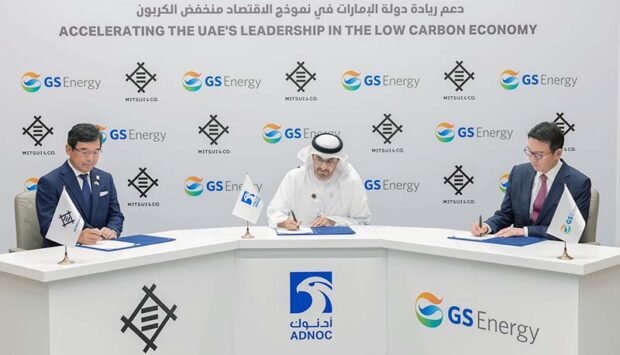Adnoc and ADQ have agreed a partnership deal with Japanese and South Korean companies on developing a blue ammonia facility at the TA’ZIZ zone in Ruwais.
Adnoc and ADQ have agreed a partnership deal with Japanese and South Korean companies on developing a blue ammonia facility at the TA’ZIZ zone in Ruwais.
Mitsui & Co. and GS Energy will work with TA’ZIZ and Fertiglobe on the plan. The statement, announced during Adipec, did not reveal the scale of the plan or its cost.
“The strategic partnerships with Mitsui and GS Energy, two of East Asia’s global energy champions, reflect Adnoc’s commitment to increase the production of low-carbon hydrogen and ammonia,” said Adnoc CEO, and United Arab Emirate Minister of Industry, Sultan Ahmed Al Jaber.
“As the world embraces the energy transition, we will work closely with our new partners to jointly develop new hydrogen markets and applications for low-carbon ammonia to meet the needs of global export markets for the energy and industry markets in Japan and Korea.”
New markets
The deal follows recent test cargo exports of blue ammonia to Japan and Korea, Adnoc said. Mitsui and GS Energy will take “significant volumes” of blue ammonia to meet their domestic demand, the statement said.
Mitsui president and CEO Kenichi Hori said the project would be the first world-scale low-carbon ammonia project in the UAE.
“Energy solutions remain a strategic focus area for Mitsui; thus, we are excited to commence this new business opportunity with Adnoc in light of global climate action,” Hori said. “As a responsible member of the global business community, we will continue to contribute to creating an eco-friendly and sustainable future.”
GS Energy president and CEO Yong Soo Huh welcomed the agreement. It is a “meaningful next step in this shared journey, contributing to achieve the ultimate goal of net zero emissions”.
Adnoc and Fertiglobe previously agreed to drive the production of blue ammonia at TA’ZIZ. They signed an agreement in June.
The deal saw the companies agree to carry out pre-front end engineering and design (FEED) and FEED work. A final investment decision is planned for 2022, they said, with start-up in 2025.





